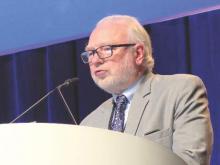In the second trial – Conventional or Hypofractionated High-Dose, Intensity-Modulated Radiotherapy for Prostate Cancer (CHHiP) – Dr. David P. Dearnaley, leader of the Clinical Academic Radiotherapy Team at the Institute of Cancer Research, London, and his colleagues studied 3,216 men who predominantly had intermediate-risk disease, most of whom first received hormone treatment.
They were randomized evenly to three radiation therapy regimens: a conventional regimen of 74 Gy in 37 fractions over 7.4 weeks, a hypofractionated regimen of 60 Gy in 20 fractions over 4 weeks, or a hypofractionated regimen of 57 Gy in 19 fractions over 3.8 weeks.
With a median follow-up of 62 months, the 5-year rate of freedom from biochemical failure or prostate cancer recurrence was 88.3% with the conventional regimen, 90.6% with the 60-Gy hypofractionated regimen, and 85.9% with the 57-Gy hypofractionated regimen.
Compared with the conventional regimen, the 60-Gy hypofractionated schedule yielded a hazard ratio of 0.84, which fell well within the predefined hazard ratio of 1.208 for noninferiority (P = .004). In contrast, the 57-Gy hypofractionated schedule yielded a hazard ratio of 1.20, which was inconclusive.
When the two hypofractionated regimens were compared with each other, the 57-Gy one was inferior to the 60-Gy one, yielding a higher risk of biochemical failure or prostate cancer recurrence (HR, 1.44; P = .003).
Results for prostate cancer mortality and all-cause mortality did not differ significantly, but numbers of events were fairly small, so “we’ll have to wait and see,” Dr. Dearnaley said.
The three regimens yielded similar rates of acute bladder toxicity of various grades, but the timing of the peak rate was earlier with hypofractionation. In contrast, acute bowel toxicity occurred not only earlier, but also at higher rates (P less than .001) with the hypofractionated regimens.
At 5 years, late bowel toxicity with the hypofractionated regimens did not differ from that with the conventional regimen; however, comparing the hypofractionation regimens, the 60-Gy one yielded a higher rate than the 57-Gy one. Similarly, for late bladder toxicity, the rate of grade 2 or worse events was higher with 60 Gy.
The trial population was somewhat heterogeneous, Dr. Dearnaley acknowledged. “We will be doing a multivariate analysis to look at all of these very detailed histopathological features, in addition to a translational study where we want to look at molecular characterization of these patients. We’ve got biopsies on most of them for that.”
“We believe that modest hypofractionation using 60 Gy in 20 fractions delivered with high-quality radiotherapy techniques can now be recommended as a new standard of care in patients with this type of intermediate- and low- and high-risk cancer,” he concluded.
“As we move toward image-guided radiotherapy – and I don’t mean just by using fiducials, I mean by using the MR scans – we can start to boost dominant lesions. And I think the effectiveness of 57 Gy in treating lower amounts of volume of cancer within the prostate may mean that we can get the best therapeutic ratio by lowering the dose a little bit to 57 Gy, but boosting our dominant lesions,” Dr. Dearnaley added.
He agreed with Dr. Lee that collectively, the findings at 5 years of follow-up are sufficient to propel hypofractionation into standard of care, noting that trials of dose escalation show that the hazard ratio for biochemical control remains stable between 5 and 10 years. Additionally, in his opinion, survival is not the right endpoint when it comes to investigating fractionation.
“So because the [prostate-specific antigen] data is robust and I don’t think that’s going to change, the critical issue is actually that of side effects. You can get late, late side effects, and I do think we have to be a little bit cautious about those,” Dr. Dearnaley said, although data from the first patients enrolled in CHHiP in 2001 have not raised any concerns.
“My view is the evidence is sufficiently robust in that large number of patients to change practice now,” he concluded.

